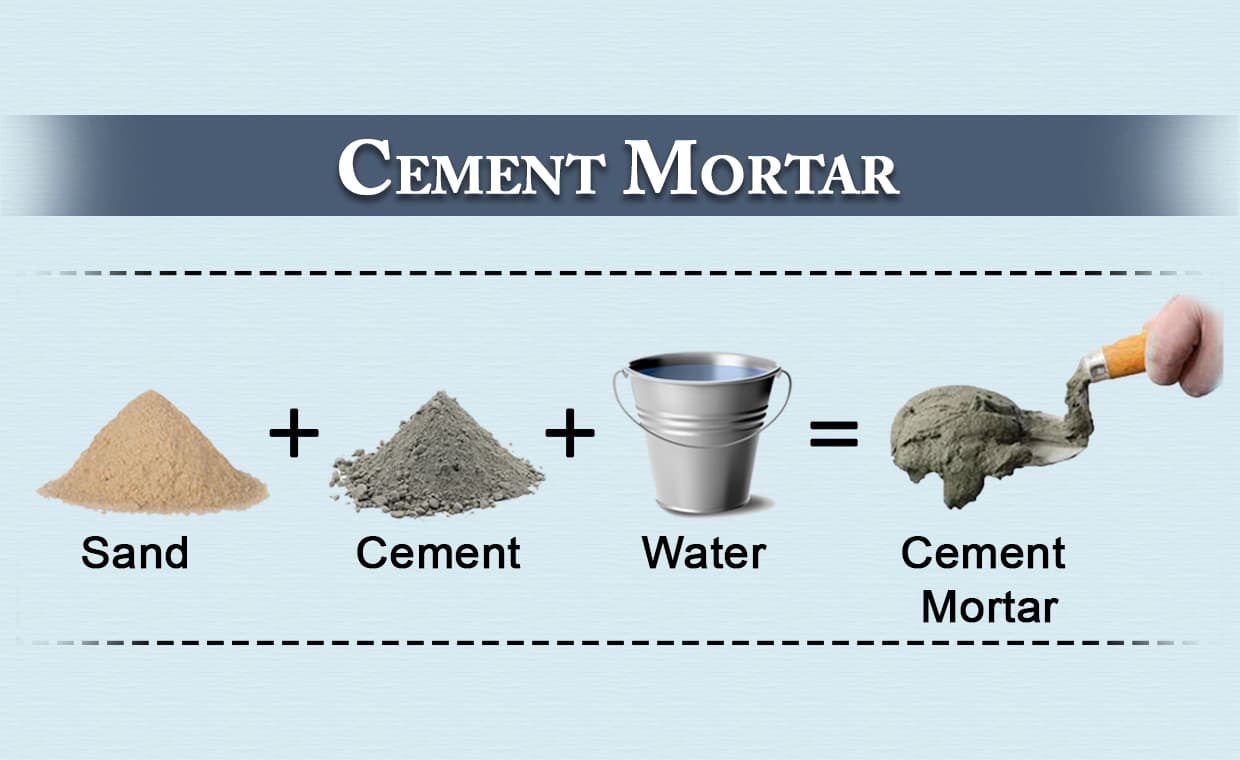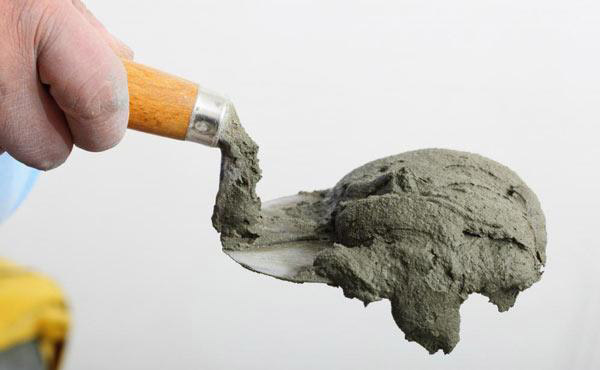
Mortar is a homogenous mixture of cement, sand and water. Different types of mortars are used in masonry construction based on their applications, binding materials, strength, bulk density and their purposes.

Nowadays, cement mortars are most commonly used as mortar in construction. Cement mortar is used in all types of construction work due to its strong and durable properties.
What is Cement Mortar?

According to ‘Frederick S. Merritt’, (Author of Building Design and Construction Handbook), mortars are composed of a cementitious material, fine aggregate, sand, and specific amount of water. Mortar can be used for a number of purposes such as plastering over bricks or other forms of masonry, for flooring etc., and with the addition of coarse aggregate, it can also be used to make concrete.
Cement mortar also provides a superior medium to create a smooth surface on walls made from bricks or other forms of masonry.
Preparation of Cement Mortar
According to ‘Satheesh Gopi’ (Author of Basic Civil Engineering), the preparation of the cement mortar involves following steps:
- Selection of Raw Materials
- Proportion of cement mortar
- Mixing of ingredients
(a) Selection of Raw Materials
Although there are different types of materials available for the preparation of Cement Mortar, it is necessary to ensure that the right materials are selected based on the type of construction and its purpose.
The Portland cement is used to make mortar. Ordinary Portland cement is most suitable for common construction purposes. For making composite mortars, Lime is also used.
Sand must be of good quality and it should be free of impurities like clay, dust, oxide of irons etc. It must be cleaned completely before mixing with cement.
Sand provides strength, resistance against shrinkage and cracking. It provides bulk to mortars, hence, making it economical. Using just cement would not only make it extremely costly, but also impractical.
(b) Proportion of Cement Mortar
The Proportion means the relative quantity of different components to be mixed to make good mortar, or simply the ratio between different materials.
Following are the proportions of cement mortar which is commonly recommended for different works:
01. Masonry Construction:
- For ordinary masonry work with brick/ stone as a structural unit. – 1:3 to 1:6
- Forreinforced brick work – 1:2 to 1:3.
- For all work in moist situations – 1:3
- For Architectural work – 1:6
- For Load Bearing structures – 1:3 or 1:4
02. Plaster Work:
- For External Plaster and Ceiling Plaster – 1:4
- Internal Plaster (If sand is not fine i.e. Fineness Modulus> 3) – 1:5
- For Internal Plaster (if fine sand is available) – 1:6
For external plaster work, as per Government of India, ‘CPWD SPECIFICATIONS (VOL.-2)’ (Central Public Works Department), the under coat shall consist of cement mortar 1:5 (1 cement: 5 coarse sand) and the top coat shall be of cement mortar 1:4 (1 cement: 4 fine sand) unless otherwise specified.
03. Flooring Work:
Mortar ratio of 1:4 to 1:8 (cement: sand, water to be judgmental), for 5 to 7 times thickness of verified tiles, should be given as bed between RCC floor and tiles.
04. Pointing Work:
- For pointing work proportion of cement mortar should be 1:1 to 1:3
(c) Mixing of Ingredients
To prepare cement mortar, cement and sand are properly mixed in dry condition. Water is then added gradually and mixed using a shovel. The water should be free from clay and other impurities.
Cement mortar can either be mixed manually (Hand Mixing) or mechanically (Machine Mixing). For small construction, hand mixing is commonly used. Mechanical mixing is required when the mortar is needed in large quantities and needs to be used in continuous order.
Curing of Cement Mortar
Cement gains strength with hydration. So, it is necessary to see that the mortar remains wet until hydration occurs. After placing the mortar/concrete, the process of ensuring sufficient moisture for hydration is called curing. Curing is ensured by spraying water. Generally, curing begins 6–24 hours after using mortar. Initially, more water is required for hydration, which can be reduced gradually. Curing for cement mortar is recommended for 7 days.
Properties of Cement Mortar
The important properties of cement mortar are:
- Well-proportioned and well laid mortar provides an impervious surface.
- When water is added to dry mixture of cement and sand, hydration of cement occurs, and it binds with sand particles and the surrounding surfaces of masonry and concrete.
- A rich mortar of more than 1:3 is prone to shrinkage.
- The leaner mix is not capable of closing the voids in sand, and hence the plastered surface will remain porous.
- As per IS: 2260-1981 (Indian Standard), the strength of the mortar depends upon the proportion of cement and sand. Strength obtained with the various proportions of cement and sand are as follows.
Uses of Cement Mortar

Its uses are as follows,
- To bind masonry units like stone, bricks, blocks, cement
- For Plastering on walls and slabs to make them impervious.
- As a filler material in Ferro cement works and stone masonry.
- To fill cracks and joints in the wall.
- Use of cement mortar gives a neat finishing work to wall and concrete work.
- For pointing the joints of masonry.
- For preparing the building blocks.
Precaution While Using of Cement Mortar
- After adding water to the mixture, the mortar should be used within 30 minutes, because the setting process begins immediately after adding water. Otherwise, its strength will gradually decrease.
- Before placing the structural units, i.e. bricks and stones they must be saturated in water because the cement requires a good amount of water for hydration. If dry units are placed on the mortar, they will absorb water from mortar very quickly, which will have a deteriorating effect on the mixture and its strength will get reduced.
- Wherever the mortar is used, it should be kept wet at least for 7 days.
In summary, the most common type of mortars of the present day generally consists of mixtures of cement and sand. In all situations where a strong, durable and resistant mortar is desired, the cement mortar becomes indispensable. Cement mortar is one of the greatest binding materials widely used in construction.
Here, we have provided information on cement mortar, proportion of cement mortar for different works, their uses and its precautions which will help you while constructing a house.
Also Read:
Most Popular Types of Flooring Materials for Your House
Rent or Buy a Home – Which is Better?
Image Courtesy: Image 1



































